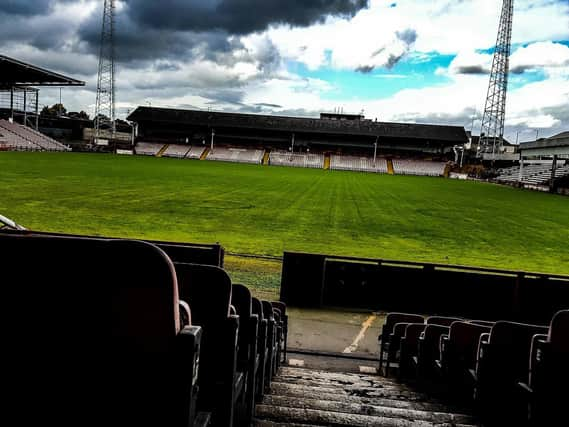Abandoned but never forgotten – Millmoor the spiritual home of the Millers


It does possess drama and a compelling plot all the same with Millmoor, that inimitable former home of Rotherham United, taking centre stage.
Glory days, legendary figures, crises and then it was all over and briefly off to an athletics stadium over the border in the Steel City before reconvening across the dual carriageway.
Advertisement
Hide AdAdvertisement
Hide AdMuseums, galleries and entertainment venues may be closed – and Millmoor’s famous Tivoli Nitespot has long since staged its last dance – but the view from Coronation Bridge overlooking Millmoor remains open and vivid.
A stadium vacated by its tenants in 2008, but still largely intact, including its half-built new main stand which was never finished. The CF Booth Ltd signage on the Railway End still standing sentinel-like.
Should you walk or drive by, you are instantly transported back – for those of us who are not teenagers at any rate.
What memories Millmoor, a stadium rich in history and unique in character, provided. Goodness, gracious me as much-loved Millers radio commentator Brian Chapple once said.
Advertisement
Hide AdAdvertisement
Hide AdIt was Chapple whose words – complete with an explosion of joy from co-commentator Gerry Somerton – painted a golden picture to describe Alan Lee’s late promotion-clinching goal against Brentford in April, 2001.
It was a moment when time stood still and one that no ‘Miller’ of a certain age will ever forget.
The Railway End also witnessed a similarly iconic moment 20 years earlier when the late Rod Fern latched onto a pass from John Breckin, that great servant of Millmoor, before firing home to secure another famous 2-1 win in the home finale of 1980-81, this time against Plymouth Argyle.
It enabled the Millers to claim the Division Three title at the expense of rivals Barnsley.
Advertisement
Hide AdAdvertisement
Hide AdSadly, tragedy would arrive on the final day of the 1999-2000 season – when the Millers and Swansea City, both promoted and competing for the Division Three championship, drew 1-1.
Rival fans had clashed before the game with brewery drayman Terry Coles, a Swansea supporter, trampled to death by a police horse in an incident on a single-lane track just behind the Millmoor Lane stand.
A central figure amid the fanfare of those more treasured times in the early Eighties and early Noughties was the man known simply as ‘The King’.
All hail Ronnie Moore, whose sign used to hang above the old Millmoor Hotel, where the club legend used to enjoy a post-match pint with supporters.
Advertisement
Hide AdAdvertisement
Hide AdIt was opposite the Railway End in front of the Tivoli where Moore mostly held court on the pitch in front of his adoring Millmoor public in his playing days with Rotherham.
As he did with Fern on an unforgettable autumnal day in October, 1981 when they destroyed Chelsea in a 6-0 rout – with Yorkshire TV cameras there to witness one of the darkest hours in the Blues’ history with visiting custodian Petar Borata never quite the same after.
Moore’s time in charge of the club produced similarly beguiling stories at Millmoor, which proved no respecter of reputation during its last hurrah.
A kerfuffle famously arose in August, 2003 when Championship newcomers West Ham refused to change in the away dressing rooms because they felt they were too cramped.
Advertisement
Hide AdAdvertisement
Hide AdThe press box was also packed that day, but no-one moaned. The old facility used to be at the opposite end of the Main Stand and was on stilts and that was far more precarious.
Unsurprisingly, no home team-talk was required that day against the Londoners and the Hammers returned south with no points and a flea in their ear from the Millers faithful.
It was a time when I covered the club for the Rotherham Advertiser. The pleasure of seeing well-heeled clubs and big-names given a reality check was something you never tired of.
Former Chelsea and Italy striker and Watford manager Gianluca Vialli’s unique food for thought involved a meat pie being thrown in his direction. Benvenuto to Rotherham, Luca.
Advertisement
Hide AdAdvertisement
Hide AdMuch earlier, Millmoor had proved fateful for another well-known forward of his day in Malcolm MacDonald.
Supermac, then in the colours of Arsenal, suffered a career-ending knee injury in a League Cup tie at the start of the 1978-79 season – the Gunners lost 3-1.
Millmoor staged many other memorable cup occasions of note, although it’s perhaps better not to mention one particularly controversial FA Cup fourth-round replay with Manchester United in 1966 to any Millers old-timers.
The Millers, who drew 0-0 at Old Trafford, cruelly lost out 1-0 after extra-time to a line-up including Best, Charlton and Law – with the hosts left incensed at referee Jack Taylor’s non-award of a ‘goal’ from John Galley. If anyone asks, it was a goal...
Advertisement
Hide AdAdvertisement
Hide AdThe Sixties saw the likes of Peter Madden and Dave Watson stride around with authority, while high-quality forwards Albert Bennett, Barry Lyons, Frank Casper, Ken Houghton and Ian Butler struck fear into the heart of many a visiting backline.
Fast-forward to the early Eighties in the era of those much-missed figures of Ian Porterfield and Emlyn Hughes and it was the turn of Moore and Fern to impose their will upon defenders, with the trickery provided by Tony ‘Tiger’ Towner.
Millmoor’s contribution to football history is also significant.
It is where the first penalty shoot-out in the FA Cup took place, with Ally Pickering bestowed with the honour of converting the winner for the Millers in a 7-6 victory over Scunthorpe in November, 1991.
Advertisement
Hide AdAdvertisement
Hide AdThe first League Cup final, when it was a two-legged format, was staged there in August, 1961, with Barry Webster and Alan Kirkham netting in a 2-0 first-leg win over Aston Villa’.
Millmoor. Abandoned, but still adored.